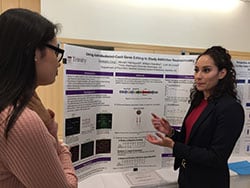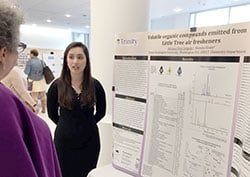Spring Research Day
On a glorious April afternoon, it was standing room only as students and faculty packed into the Payden Center to present this year’s undergraduate research projects and hear from some of the best student researchers, and check out many prestigious research opportunities on display during Spring Research Day. This has become an important “new tradition” at Trinity, showcasing student research projects from many disciplines.

Students present their research projects at Spring Research Day
Retrospective Analysis of Barrett’s Esophagus: The Role Body Mass Index Plays in Successfully Treating BE and in the Recurrence of Dysplastic BE
Laura Garcia with Abigail Furlong, Rebecca Edwins, Petra Prins
Defined as intestinal metaplasia in the distal esophagus, Barrett’s esophagus (BE) is considered to be a complication of gastroesophageal reflux disease with an increased risk for the development of esophageal adenocarcinoma if left untreated. As of today, this pre-cancerous lesion affects over 2 million Americans and it is expected to grow. Depending on the grade of dysplasia a BE patient is diagnosed with, different therapies and treatments are used in hopes of achieving complete remission of intestinal metaplasia (CRIM). Once CRIM is achieved, patients are placed under surveillance in order to detect any recurrence of the Barrett’s. There is no reliable estimate of recurrence risk after CRIM due to lack of research. However, it is estimated that the recurrence of dysplastic BE after treatment can reach 4% per year. Based on clinical disease outcome data, there might be a direct association between the body mass index (BMI) and the likelihood of achieving CRIM as well as the likelihood of having a dysplastic recurrence.
We performed a retrospective analysis of BE patients treated at Georgetown University Medstar, to investigate any correlations between BMI at time of diagnosis, achieving CRIM and grade of dysplasia at recurrence, to determine if BMI could be a potential predictive value in the successful treatment of BE. Our analysis showed that the majority of the patients who reached CRIM had a lower BMI (<30). We observed recurrence after CRIM in 13% patients and 83% of these recurrences were found to be non-dysplastic. Patients with a BMI greater than 30 displayed higher incidences of dysplasia at time of recurrence. This study indicates that BMI could be a predictor for successful treatment of BE and that reducing BMI might be beneficial for the course of this disease.

Kimberly Cruz
Using AAV-Mediated Cas9 Gene Editing to Study Addiction
Kimberly Cruz
Alcohol addiction, characterized by uncontrolled drinking and preoccupation with alcohol, affects 3 million people in the United States every year. Genetics and neural circuit activity are important factors in alcohol addiction that we can now address with sophisticated tools for neural circuit-specific genome editing. Hypocretin (Hcrt) is a neuropeptide exclusively produced in the lateral hypothalamus, a brain area strongly linked to drug reward. The Hcrt system is most known for its role in arousal (wakefulness), but studies show a significant role for Hcrt receptor 1 (HcrtR1) signaling in alcohol-seeking behavior. We investigated the role of HcrtR1 in the Bed Nucleus of the Stria Terminalis (BNST), a structure comprised of diverse cell types linked to distinct emotional-related behaviors.
We used cell type-specific CRISPR-Cas9 gene editing in mice to manipulate HcrtR1 expression in different populations of BNST neurons. We hypothesized that genetic disruption of HcrtR1 expression in specific BNST neuronal subpopulations would alter excessive alcohol drinking. We found that HcrtR1 is expressed on multiple BNST cell types, including BNST neurons containing the neuropeptide Tac1 (Tachykinin 1), which are implicated in binge alcohol drinking. Cell type-specific CRISPR-Cas9 disruption of HcrtR1 specifically in Tac1-BNST neurons did not significantly alter long-term alcohol drinking. Although other data suggest that Hcrt actions in the BNST are important for motivated behavior and addiction-related phenotypes, these effects are most likely not mediated by Tac1-BNST HcrtR1 signaling.

Raissa Audrey Tseumie
Human Endogenous Retrovirus Long Terminal Repeats are Activated by Retroviral Proteins
Raissa Audrey Tseumie
Increased human endogenous retrovirus (HERV) expression has been detected in several different human cancers including melanoma and lymphomas as well as autoimmune disorders, neurological disorders and HIV-1 infection. HERV-K type 1 are capable of producing the accessory protein NP9, or type 2 viruses, which can produce the accessory protein Rec. During HIV-1 infection, the regulatory protein Tat enhances the efficiency of viral transcription. Previous studies have shown that the HIV-1 Tat protein may also play a role in activating HERV-K transcription from the long terminal repeats (LTRs). We hypothesize that NP9 may enhance the efficiency of HERV-K viral transcription by interacting with the HERV-K LTR, similar to the role of HIV-1 Tat and the HIV-1 LTR. To test this hypothesis, the LTRs were cloned into the luciferase plasmid pBV-Luc. Verified plasmid were transfected into 293T/17 cells using the following combinations: 20ng of the HIV-1 LTR-Luc plasmid with 30ng or 100ng each of HIV-1 Tat or Rev or HERV-K Rec or NP9; 100-250ng of the HERV-K LTR plasmid with 30ng or 100ng each of the plasmid expressing HIV-1 Tat or Rev or HERV-K Rec or NP9. After Luciferase assays, Light Units were detected with a Promega GloMax. Our results confirm that HIV-1 Tat activates the HIV-1 3’ LTR. However, when the HERV-K LTR-Luc Plasmid was co-transfected with the plasmid expressing HIV-1 Tat, our results showed no activation of the LTR. Additionally, our results were inconclusive when the HIV-1 Rev, HERV-K Rec or Np9 were co- transfected with the HERV-K LTR-Luc plasmid.

Adriana Pino Delgado
Volatile Organic Compounds Emitted from Little Tree Car Air Fresheners
Adriana Pino Delgado
Air quality in motor vehicles is a function of the outdoor environment and also the use of scented products inside the car cabin. Little Trees air fresheners are commonly-used products designed to hang in from the rear view mirror. To determine the volatile compounds emitted by these products, three types were analyzed for their emissions by headspace and gas-chromatography mass spectroscopy (GC MS). Several compounds detected are known to react with components of air associated with vehicular emissions and smog. To determine how the compounds are emitted in an actual user environment, air samples were collected by solid-phase microextraction (SPME) from inside a vehicle before and during the use of a Little Tree air freshener. Analytes collected on the SPME fiber were analyzed by GCMS.
Hypertonia Machine
Marcella Gutierrez with Naomi Dereje
Hypertonia is a movement disorder that affects children with cerebral palsy. It is characterized by tight muscle contractions that decrease the efficiency of muscles, and in some cases prevent muscle use entirely. Hypertonia has three different subtypes: rigidity, spasticity, and dystonia. Each subtype has different symptoms; however, in clinical studies, there is trouble deciphering each subtype. The goal of this project is to develop a quantitative way to distinguish the three subtypes of hypertonia. The goal for the allotted period was to try and finalize electrical and mechanical components to be ready for initial testing. The mechanical design included adding additional comfort and making sure that the motor was connected onto the machine. Electrical design included designing a PCB (printed circuit board), soldering pin connectors onto the board, connecting wires, and making sure wires were connected. In the future, we plan to collect data from children with cerebral palsy using this device and develop a computer algorithm to distinguish and quantify the three types of hypertonia.
A Sampling of Other Presentations at Spring Research Day
Biomedical Sciences
- Volatile Organic Compound Profile of An In-Car Cabin Commute in DC – Nyanda Wright
- Exposing Hazards of Plug-in Air Fresheners – Danielle Vado
Chemistry
- Which Foods Best Catalyze Chemical Reactions? – Marcela Gutierrez
- Alternatives to Salt for Lowering Temperature for Ice Formation – Gianni Segears
- Transition Metal Complexes: How Metal Ions Affect Color – Samantha Lazo-Contreras
Environmental Science
- Water Pollution in Flint, Michigan – Marilyn Rivas
- North Dakota Pipeline – Kimberly King
- Landfills – Jessica Corvera
Business Administration
- Big Pharma: Sustainability Practices – Alauna Keaton
- Case Study Analysis of the Hershey Corporation – Maria Santos
- Nike’s Ecological Conversion – Sarai Burnett
Communication
- Morally Ambiguous Characters in Primetime Television – Courtney Radden
- Media Portrayals of Black Males – Patrice Sykes
- Devious Maids and Desperate Housewives: The Misrepresentation of Latinas in Primetime Television – Stephanie Reyes
Education
- Math Self-efficacy of 4th Grade Boys and Girls – Marisela Tobar Henriquez
English
- Who am I to be Touched at Random: Black Feminism in Poetry – Arryn Harris-James
- From Slave Girls to Today’s Girls – Summer Faulk
- Aping the White Hegemony: Respectability Politics’ Impact on the Black Community and Individual Identity – Emma Kamara
- Show Me a Monster, I’ll Show You a Mirror – Shanta Bryant